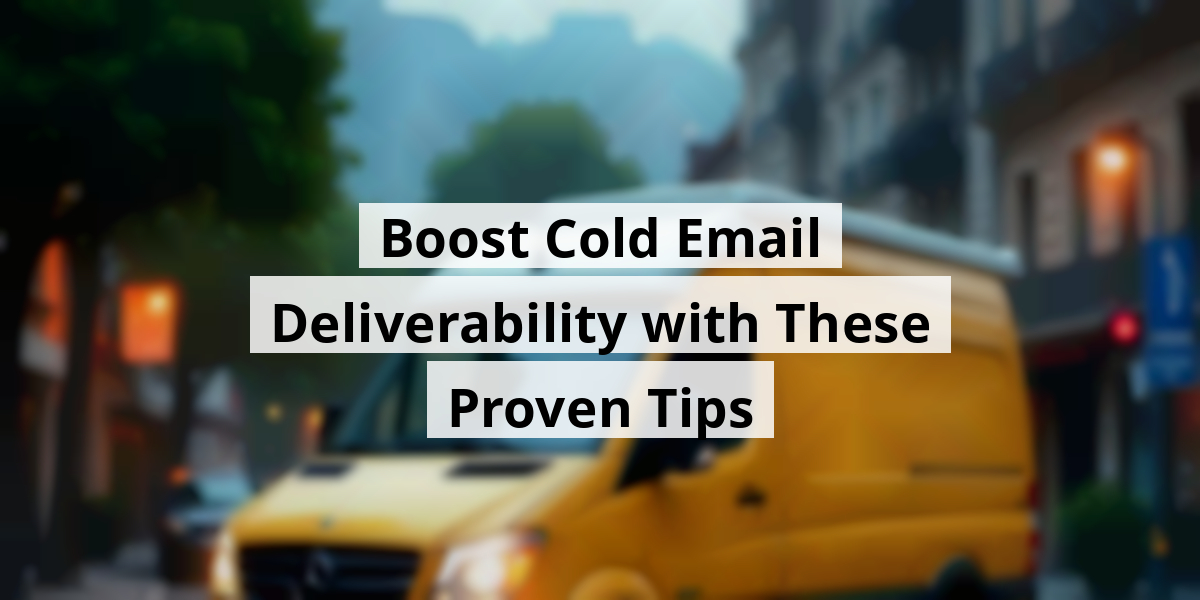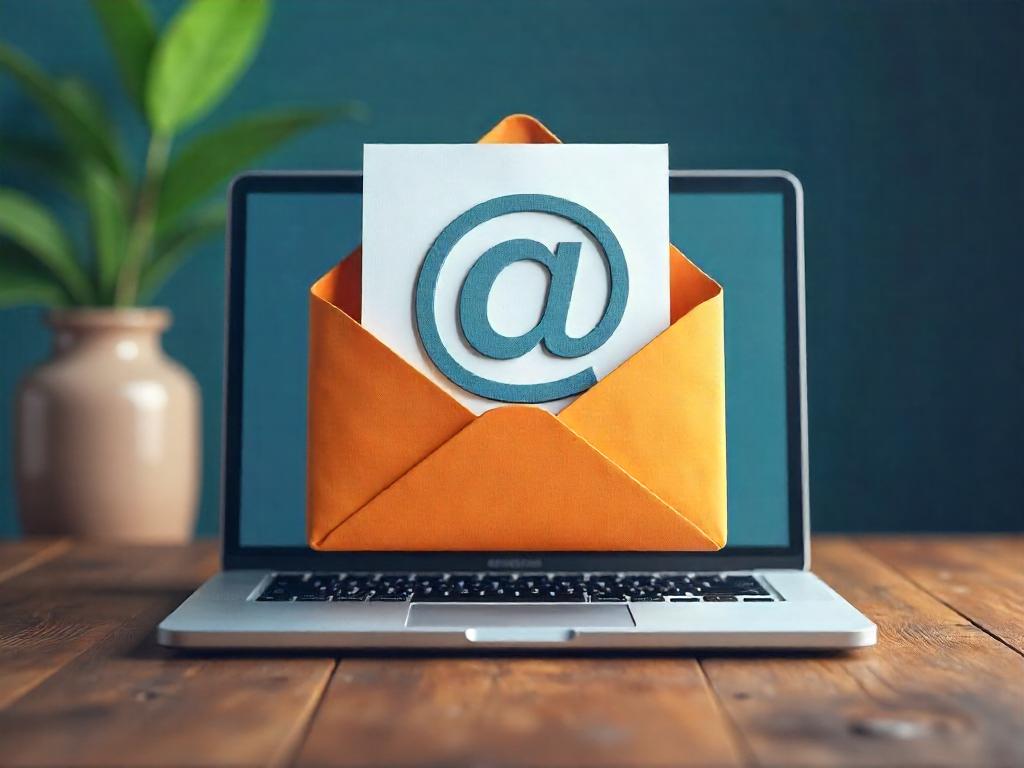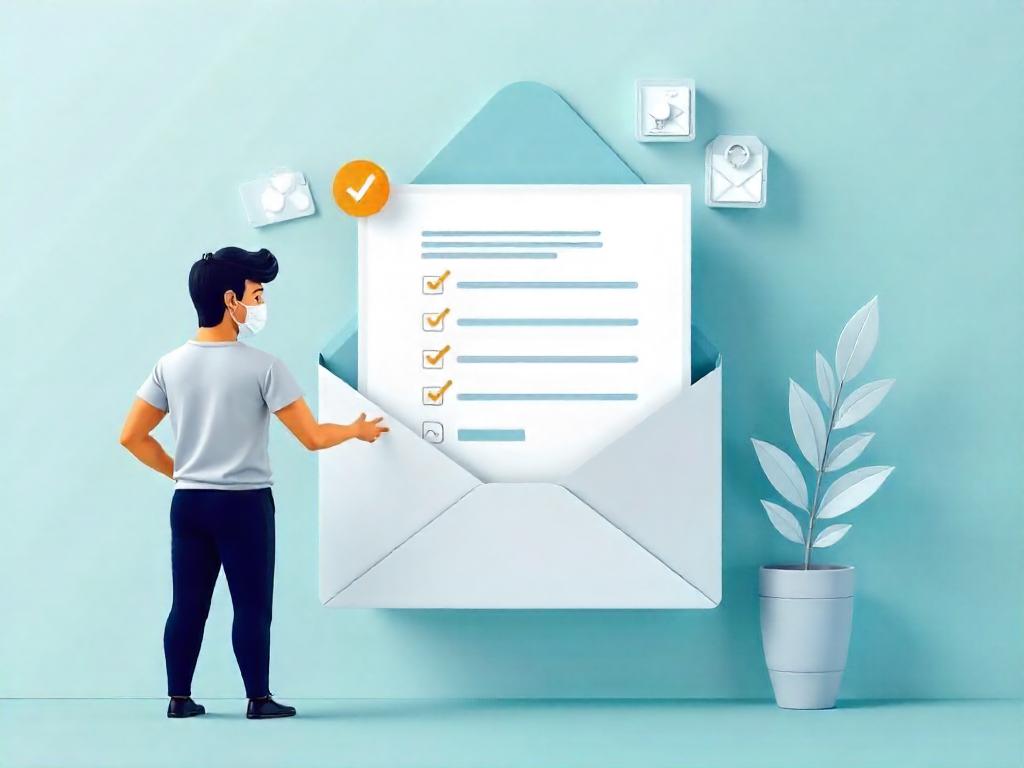 LIMITED SPOTS
All plans are 30% OFF for the first month! with the code WELCOME303
LIMITED SPOTS
All plans are 30% OFF for the first month! with the code WELCOME303

 LIMITED SPOTS
All plans are 30% OFF for the first month! with the code WELCOME303
LIMITED SPOTS
All plans are 30% OFF for the first month! with the code WELCOME303


Now we are going to talk about ensuring our emails land right where we want them—in the inbox, not the dreaded spam folder. We've all had that moment, right? Sending out an email with enthusiasm, only to discover it’s been exiled to the junk yard. So let’s break down what makes cold email deliverability tick!
Cold email deliverability is essentially the magic trick of getting emails to the right place. It's like throwing a party and hoping people actually show up instead of sticking to their couches. Imagine crafting the perfect email about your new product or service, and it lands squarely in the abyss of “Promotions” or worse, “Spam.” Talk about a buzzkill!
Several factors play into this scenario:
Real talk: we recently experimented with our email campaigns, and it felt like throwing spaghetti at the wall! One version of our email was a masterpiece, full of witticisms and value. Sadly, despite the effort, it became a friendly resident of the spam folder. It's a constant reminder that content is key—but not just any content. It’s about relevance and understanding what your audience wants to see. And let’s face it, even with Shakespeare’s eloquence, an email titled “Revolutionize Your Life with These Products” might just trigger the spam filter alarm bells.
Another pitfall we often encounter? Generic templates. If we wouldn't want to read it over breakfast, guess what? Our audience won’t be thrilled about it either. We learned that blending personalization into our emails worked wonders. Instead of starting an email with "Dear Sir or Madam," how about referencing something relatable? “Hey, I hope your morning coffee was as strong as my enthusiasm for my new project!” That might just earn a chuckle and, more importantly, attention!
With email deliverability, every small tweak can make a world of difference. The key takeaway here? It pays to be authentic. So, let’s roll up our sleeves, check our domains, be funny (or at least try), and make sure our emails are the life of the party instead of the wallflowers!
Now we are going to talk about what makes cold emails land in the inbox rather than the dreaded spam folder. Brainstorming the factors that influence this can simplify our outreach efforts and, ultimately, improve our chances of getting a response.


The first thing to ponder is domain reputation. Think of it as your email’s *social credit score*—the better it is, the easier it is for emails to slide into inboxes rather than getting tossed into the spam abyss.
If your domain has a history of being flagged, email providers are going to treat it like a questionable character at a cocktail party—no one wants to engage! To keep it on the up and up, make sure you’re using SPF, DKIM, and DMARC. That’s like putting up a “Nice Guy” sign in the crowded email world.
And hey, if you’re fresh to the email game or using a new domain, take it slow. Gradually ramp up your sending volume. It’s like dating; you don’t want to bombard someone with love letters right off the bat.
Next up: the email content! Ah, the age-old question of “what do I write?” The reality is, the email structure can be a deal-maker or a deal-breaker.
Your subject line shouldn’t read like a used car salesman wrote it. Keep it short, friendly, and straightforward. Avoid those flag words that scream “Spam alert!” If you find yourself typing the word “free,” for instance, stop right there—back it up like a contestant on a game show who just hit the buzzer by accident!
It's wise to personalize whenever possible. Think of it as throwing a little sprinkles on a cupcake. Adding the recipient's name or tailoring the content to their interests makes the email feel more special. And, remember, email formatting matters too—keep it simple to avoid those embarrassing rendering issues that leave your email looking like a toddler's finger-painting project!
Lastly, sender behavior plays a huge role in deliverability. Imagine showing up to the office every day with a different set of colleagues—it can get confusing! Aim for consistency in your sending volume and engage only with a clean, well-maintained email list.
If folks are opening your emails and replying, that’s a green flag for email providers. Keep an eye on engagement, but don’t be shy about testing different email variants. A/B testing is like trying on clothes before buying; you need to see what fits best to optimize your results! For teams exploring reliable platforms to run these experiments, G2 highlights some of the best A/B testing tools that marketers rely on to refine campaigns and boost conversions.
Utilizing platforms like Growleady can simplify this juggling act by offering tools for targeted cold outreach and monitoring performance, allowing us to focus on converting opportunities instead of fretting over deliverability issues.
Now we are going to talk about some essential ways to boost cold email deliverability. This isn’t just about hitting send and hoping for the best; it’s more like crafting a love letter—seriously! Let's get into it.

Picture the day when your emails straight-up waltz into the inbox instead of getting stuck in spam land. To pull that off, we need to put on our digital detective hats and authenticate our domains. This means rolling out the big guns—SPF, DKIM, and DMARC. Think of them as the bouncers of your email club. These protocols ensure that your correspondence is as legitimate as grandma's cookie recipe, minimizing the odds of your messages ending up in the spam slammer. For new domains, start slow. It’s like easing into a cold pool; jump in too fast, and it'll be a shock.
A contact list isn't just a collection of names; it's a treasure trove! We should be filling it with people who actually want to know about your offerings. You know those opt-in forms? They’re golden. LinkedIn engagements? A great idea! Buying lists? Well, that’s like bringing a rubber chicken to a gourmet dinner—totally misses the mark! Use email verification tools like a digital broom to sweep out the cobwebs of inactive addresses. Your sender reputation will thank you.
Just like how you wouldn't give a gift without knowing your friend's taste in music, we shouldn’t send generic emails. Personalization is the secret sauce that makes recipients say, “Hey, this is for me!” Mention their name, company, or a quirky detail about their industry. For instance, if we’re targeting SaaS firms, referencing specific hurdles they face can work wonders. Avoid cookie-cutter templates like the plague; instead, create a message that feels like a tailored suit—sharp and fitting.
Let’s face it: to navigate the chilly waters of cold emailing, we need to track how well we’re doing. Analyzing metrics like open rates, click-through rates, and bounce rates can be as enlightening as a morning cup of coffee. If bounce rates are high, it might be time to refresh our contact list, while lower open rates could signal that those subject lines need a little pep talk. Experiment with A/B testing—the scientific method of the email world. Swap out subject lines or tweak sending times until we find what really speaks to our audience. Integrating email analytics software can be the cherry on top for keeping us in the loop.
| Strategy | Action Item | Expected Outcome |
|---|---|---|
| Email Authentication | Implement SPF, DKIM, DMARC | Increased inbox placement |
| Build Quality Lists | Use opt-in forms | Higher engagement rates |
| Email Personalization | Customize based on recipient | Improved response rates |
| Performance Metrics | Track open and click rates | Informed strategy adjustments |
Now we are going to talk about common pitfalls that can sabotage our cold email efforts. If you've ever felt the sting of sending out emails into the void, you know what we mean. So, let’s unpack these mishaps with a sprinkle of humor and a dash of wisdom.
We’ve all been tempted to snag those shiny, pre-packaged email lists, haven’t we? But let’s be real—it's like buying a used car without checking the mileage. Those lists come with a hefty dose of invalid emails and uninterested folks
–worst case scenario, our emails end up as spam! Instead, let's earn our stripes by cultivating our own lists through genuine connections, LinkedIn chats, or friendly networking at events.
Ah, the thrill of giving email providers a reason to doubt us! If we don’t authenticate our domain, it’s like trying to enter a VIP club without a pass.
Setting up SPF, DKIM, and DMARC is crucial to assure our emails won’t end up in the dreaded spam folder.
Think about it: sending cold emails from Gmail or Yahoo is like showing up to a formal dinner in flip-flops. A professional domain—like ourname@business.com—adds instant credibility.
We want our emails to exude confidence, not casualness!
Who knew using “free trial” could be as dangerous as saying “Voldemort” in a Harry Potter movie? Overloading our emails with spam words and too many links can send them straight to junk. Buckle up to clear out fluff, and let’s aim for sharp, concise messaging that resonates with our audience. A/B testing, anyone?
Suddenly blasting thousands of emails might seem like a power move, but it actually screams “red flag!” Gradually increasing our email count is the smart play.
Think of it as easing into a cold pool—little by little until we’re ready to make a splash. Tools like Mailshake or Lemlist can help us through the warm-up.
Generic emails? Yawn! Personalizing our messages is crucial. Everyone wants to feel special, right? Instead of saying, “We help businesses grow,” try “Helping [Recipient’s Company Name] Capture More Leads.”
That’s how we turn a cold email into something warm and fuzzy.
Ignoring metrics is like driving blindfolded. Keeping an eye on bounce rates and reply rates helps us tweak our strategies.
Tools like Reply.io or Apollo can act as our GPS in this journey, guiding us back on track when we go off course.
No one likes a clingy friend, and recipients aren’t keen on receiving too many email follow-ups either. Let’s space out our messages—two or three thoughtful follow-ups over several days can do wonders.
Quality interactions over quantity, folks!
So let’s steer clear of these common errors, and we’ll find ourselves crafting cold emails that actually get opened and responded to. Having a laugh while doing it doesn’t hurt, either!
Now we are going to talk about some handy tools that can really boost the chances of your cold emails actually landing in inboxes. We've all been there, right? You hit send on what you think is a stellar email, and then… crickets. So, let's spice things up and tackle this together!


Think of authentication tools as the bouncers at a VIP club—they evaluate who’s allowed in. Tools like Google Postmaster Tools or MXToolbox are there to verify your domain with necessary protocols like SPF, DKIM, and DMARC. Imagine sending an email that’s like your friend who never shows up empty-handed—they come with reputation points, making sure you’re not headed for the spam folder!
Everybody loves a clean house, right? Well, email verification tools are your cleaning crew for contact lists, ensuring you only reach genuine accounts. Platforms like ZeroBounce or NeverBounce will help keep your email reputation squeaky clean. Just like we declutter our homes, this will prevent your emails from bouncing back like a super ball on steroids.
No, not that croissant at the café. Email warm-up tools like Lemwarm help raise your sending activity gradually. Think of it as stretching before a workout. You wouldn’t dive straight into a marathon, would you? Building up your reputation means your emails get a VIP pass to inboxes instead of the dreaded spam zone.
Ever feel like you're juggling too many balls while sending emails? CRM tools like HubSpot make life easier by meshing your sales outreach with email communications. It’s like having a personal assistant who not only reminds you of meetings but also ensures you follow up on that killer email you sent last week. Templates and A/B testing? Easy-peasy!
Anti-spam solutions like Spamcheck.io are like your linguistic coaches. They point out those words you shouldn't say at the dinner table—like “free” or “limited time!” They keep your emails from being the equivalent of wearing socks with sandals at a fashion show.
Ever wonder how effective your emails really are? Campaign tracking tools provide insights into your outreach. Services like Growleady measure key metrics so you can adjust your strategy. You know what they say: if you can't measure it, you can’t improve it!
Don’t forget about good ol’ LinkedIn! Tools like LinkedIn Sales Navigator help supplement your cold emailing with a bit of warmth. It’s like going to a networking event where you’re not only chatting but also connecting with people after the event. Win-win!
Lastly, appointment scheduling tools like Calendly make life a whole lot easier. Imagine being able to nab a meeting slot without playing a never-ending game of email tag. Book it and move on—now that’s what we call efficiency!
Embracing these tools means we’re not just sending emails—we’re crafting connections. So, let’s gear up and improve our strategies, making those cold emails as warm as a freshly baked cookie!
Now we’re going to talk about how to improve cold email deliverability with some practical insights and a sprinkle of humor. Who knew sending an email could be as tricky as trying to find your car keys when you’re running late? Let’s dig into some tips that can help us avoid the spam folder!
Now we are going to talk about some essential questions that many people have when it comes to email marketing and deliverability. These questions pop up more often than a cat video on your feed, and let’s face it, we all want our emails to land in the right inbox.

Buying email lists sounds tempting—like a magic potion for instant subscribers—but it usually backfires. Imagine sending an invite to a party, but half the addresses lead to empty houses. You've got people who don't want to hear from you.
These lists often come with a side dish of invalid or apathetic addresses. If people aren’t interested, your bounce rates soar like a cat in a laser pointer chase. Styles like this can tarnish your sender reputation, making you end up in the dreaded spam folder.
Domain authentication is like the VIP pass for your emails. Setting up SPF, DKIM, and DMARC can feel as complicated as a Rubik's Cube at times. But believe us: it builds trust with email providers. And nobody wants to hang with the spam crowd!
Spam trigger words are like digital red flags. They include gems like "free," "discount," and "act now." Including these in your emails can set off alarm bells, causing filters to treat your perfectly crafted message like an unwelcome party crasher. Trust us, you want to keep the “party” vibe going and avoid those pitfalls!
A/B testing is the ultimate experimentation tool—think of it as taste-testing different recipes at a potluck. It allows us to determine which subject lines or email versions create a buzz and which ones flop like a lead balloon. The results can drastically boost engagement rates, making our emails more reliable.
Absolutely! Tools range from email verification services to domain authentication apps. Imagine these as your email's superhero squad. With them, you can monitor, enhance deliverability, and ensure all our messages are flying through the digital skies instead of getting caught in spam nets.
| Topic | Explanation |
|---|---|
| Purchased Email Lists | Often invalid, leading to high bounce rates and poor sender reputation. |
| Domain Authentication | SPF, DKIM, and DMARC verify your email's legitimacy. |
| Spam Trigger Words | Words that may activate spam filters like “free” and “guaranteed.” |
| A/B Testing | Helps refine content and strategies to improve engagement rates. |
| Delivery Tools | Services to enhance email deliverability and monitor outreach. |

